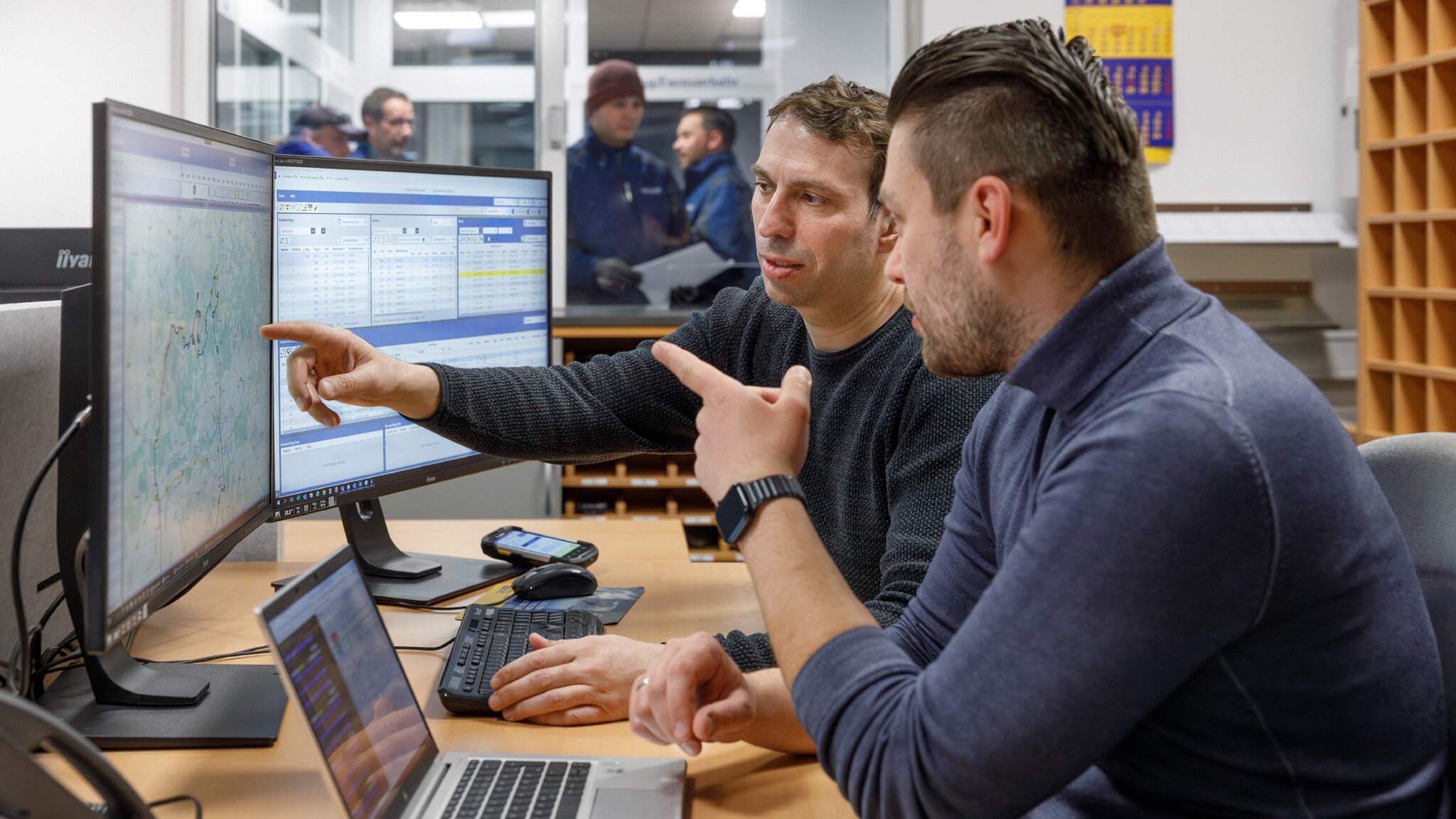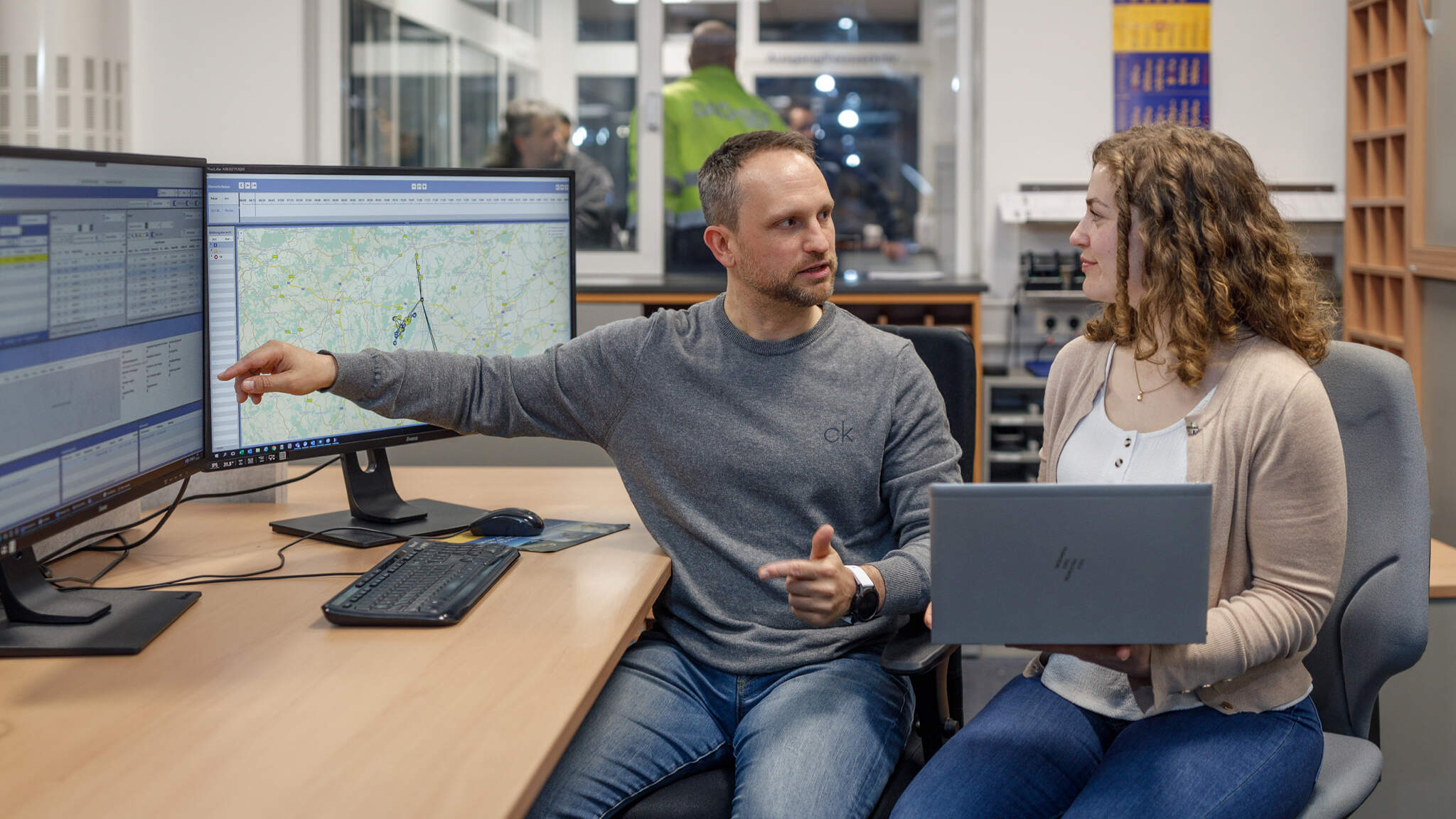Comprehensive overview
The pulse of logistics is particularly palpable in short-distance transport. To maintain an overview here and for optimum process control, DACHSER has launched new software in Europe: Short Distance Planning. This is the story of a system change.

While others still lie fast asleep, or are perhaps just turning over in their beds, here things are already heating up: at DACHSER’s Augsburg logistics center in Gersthofen, rush hour starts at five in the morning. The gates are a blur of action. Trucks dock every minute and are then unloaded and loaded before setting off a short time later to their destination.
That sounds like mayhem. But Markus Spanrunft and Muhammet Yilmaz are utterly relaxed, saying that everything is going exactly to plan—just the way it has to be. The two dispatchers have their workstation some distance away from all the hustle and bustle in the open-plan office, where the first signs of dawn are beginning to appear beyond the windows. Each of the men has two large screens that show the entire transport and loading process in real time. There’s no sign of the papers, dockets, or forms that usually pile up on a dispatcher’s desk. “Welcome to the paperless world,” Spanrunft says, grinning.
Short Distance Planning is the name of the program that DACHSER is using to completely reorganize and digitalize its short-distance transport scheduling. At its core is software that uses algorithms and artificial intelligence to optimize the shipment process and greatly advance supply chain visibility. “And it’s all as clear and as user-friendly as possible,” says Carina Klaus from DACHSER’s Production Processes & Applications department. Together with her colleague Dennis Adler, she came to Gersthofen today from the Head Office in Kempten to see how the new software performs in everyday use and to exchange ideas with the dispatchers on how it might be optimized.
From everyday practice for everyday practice
“The decision to digitally record and manage short-distance transport in a completely new way came about from a research project that DACHSER launched several years ago together with the Fraunhofer Institute for Transportation and Infrastructure Systems IVI,” says Dominik Schnatterer, Department Head Production Processes & Applications at DACHSER. “This project later became the Idea2net project Short Distance 2.0. As part of the company-wide Idea2net idea management program, employees were then asked to contribute ideas from their everyday experience—and we ended up receiving over 340 proposals.” Based on those, DACHSER’s IT specialists then worked up the first graphical user interface and tested its user-friendliness and practicality in several user interviews. “The result is Short Distance Planning—a transport scheduling innovation that emerged from everyday practice to benefit everyday practice,” Schnatterer says.
“Short Distance Planning puts a whole new control panel at our fingertips, which we can use to trigger automated processes and to see all shipment data at a glance.”
Following an initial beta version and extensive testing, ten pilot branches were equipped with the new software last year. A Europe-wide rollout got underway in the fall. “From the very beginning of our development work on the system, we always had all of DACHSER’s European Road Logistics branches in mind. We had no intention of creating an isolated solution that works only in individual countries,” Schnatterer says. System implementation in Europe is now running in seven waves over about two years, with 142 branches expected to be using Short Distance Planning by 2024. Branches on the Iberian Peninsula will also be added as soon as DACHSER’s own Domino transport management system has been introduced there.
“It takes a strong team to deliver a new software program that supports users, partners, and customers throughout the European network in such a short time,” Schnatterer says. “Our core team brought together around 20 colleagues from the branches, IT, requirements management, and my department, so we definitely benefited from meshing a lot of different skills and experience.”

Noticeably easier
The IT developers were especially keen to receive feedback from users in the pilot branches—and this turned out to be highly positive right from the start. “In transport scheduling, we come from a very heterogeneous landscape with different data sources and delivery situations,” Klaus says. “This has left us with lots of different forms, documents, and dockets that emerged in the past, which create plenty of administrative work for the dispatchers and drivers, but don’t do anything to support the flow of information in the ongoing process.” In contrast, Short Distance Planning delivers a great deal of process harmonization and standardization with an intuitive user interface. “It makes everything noticeably easier and does so right off the bat, because the system is practically self-explanatory and you can start working with it right away.”
Maximum supply chain visibility is the goal, and for the DACHSER team it also stands as a clear message. “At DACHSER, digitalization is never an end in itself; it serves people, not the other way around,” Schnatterer points out. “That’s why algorithms aren’t in charge with Short Distance Planning. Rather, they make suggestions that offer scheduling staff and drivers the best possible support in their daily work.”
For instance, the use of this new software has already tangibly improved communication between dispatchers and drivers. This is very much in evidence in Gersthofen, where paperwork no longer piles up at the dispatch counter, because Short Distance Planning transfers the data wirelessly to handhelds—leaving people noticeably more relaxed. But this hasn’t brought direct interaction between scheduling and the drivers to an end. “While the delivery process is still ongoing, we can communicate things like a route change due to traffic events,” Spanrunft says.
“Our goal is to always deliver to customers on time and to achieve the precise delivery window with the capacity available at that time,” says Christian Schnabel, DACHSER’s operations manager in Gersthofen. This sums up people’s expectations of the new system—and the experience gained with it so far in logistics practice confirms his team’s outlook. “Short Distance Planning puts a whole new control panel at our fingertips, which we can use to trigger automated processes for things like notification and to call up all shipment data in real time,” Schnabel is pleased to say. “That means we can be proactive in our route planning, not just reactive.” It also brings maximum transparency to scheduling processes. “The fact that this also greatly increases delivery rates in the selected delivery windows is something that our employees, the drivers, and our customers all very much appreciate. And because it produces scheduling results earlier and more precisely, Short Distance Planning also optimizes the flow of goods in our transit terminal. So everyone’s a winner.”
It is now daylight in Gersthofen. By eight o’clock, things have quieted down considerably in the transit terminal. For Spanrunft and Yilmaz and their visitors from Kempten, this was an opportunity to take another look at the processes. “It’s just great how easy the system is to understand and use,” Yilmaz says. “It’s so much fun.”

